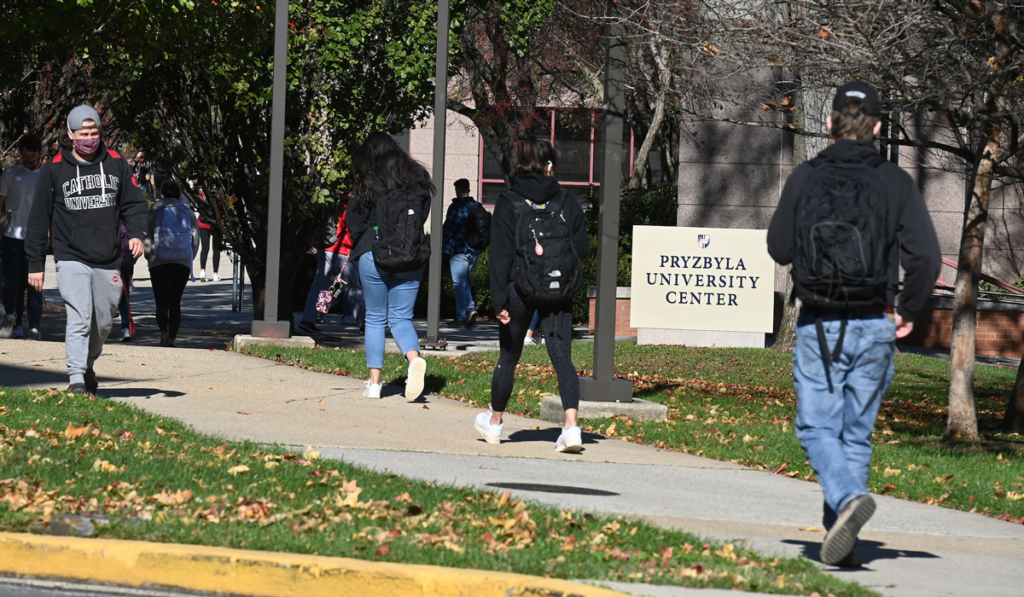Catholic University’s Spring Plan Compared to Other D.C. Universities

Image courtesy of The Catholic University of America
By Noelia Veras
Catholic University President John Garvey announced on October 27 that the university was preparing to have in-person classes and house as many university students as possible on campus. Since then, the university has remained faithful to its mission to expand the student presence via on-campus housing and in-person classes.
The spring semester plan announced by President Garvey promised that more than 50% of courses would be held in person and that a total of 1,172 students would be living on campus in single residencies.
The spring agenda for Catholic University, however, is quite different from the other universities in D.C., save for the cancellation of spring break that all universities have announced.
Like Catholic University, American University is holding some classes on campus, but unlike CUA these classes are determined by major. According to American University’s coronavirus information page, in-person classes are available for science majors, visual and performing arts majors, media studies majors, and select other areas. Additionally, although the number of in-person classes has increased since last semester, the majority of spring classes are being offered online.
According to a recent update, George Washington University is committed to continuing a fully-online course of study for all undergraduate classes and most graduate classes. According to the same update, George Washington University is also implementing a tuition reduction, like they did last semester, of 10% for students who are not living on campus. In the same report, the university administration made clear that commencement will most likely not be held in-person this year.
Howard University has not made a decisive decision on commencement; however, the university announced in a statement from university President Wayne A. I. Frederick that it is maintaining its decision to conduct classes fully online. In the same report, President Frederick also congratulated the community for its accomplishments during the tumultuous semester.
“Despite the unusual and challenging circumstances that we have endured during the Fall semester, I remain incredibly proud of our accomplishments during the pandemic and how they align with our shared vision of moving Howard Forward,” President Frederick said. “…To date, we have not conducted furloughs or layoffs. And the vast majority of our students, faculty and staff have remained healthy and safe from a virus that has disproportionately impacted communities of color.”
Georgetown University is offering some hybrid courses for senior undergraduate students and graduate students, as well as medical, nursing and law students. Nevertheless, all courses are offered virtually. In terms of housing, during the fall semester, Georgetown University housed 500 students, and doubled this number during the spring semester.
As for coronavirus cases and prevention plans on each of these campuses, the universities who have elected to house students have been implementing preventative measures accordingly.
Catholic University has employed and is still undergoing a quarantine order until February 7 for all students living on campus. Strict adherence to mask enforcement has also taken place, and select students have even been appointed as health ambassadors to make sure everyone is socially distancing and wearing masks.
“The idea is to have a presence of peers who can lead others and model good behavior when it comes to wearing face coverings, washing hands, and practicing physical distancing,” said Director of Campus Activities Steve Kreider, according to the Catholic University website.
American University provides students with certain requirements for traveling to D.C. and residing on campus. The university is requiring students to obtain a negative coronavirus exam within 72 hours of arriving in D.C. and self-quarantine for 14 days.
George Washington University has been keeping close track of their cases on campus and monitoring the situation as well.
“The GW COVID-19 Testing Dashboard is updated every day and provides aggregate and daily testing numbers, results and positivity rates for the approximately 6,200 members of the on-campus community, who are required to take part in the regular testing protocol as a condition of access to campus,” according to the GW COVID-19 Testing Dashboard.
According to its COVID-19 testing dashboard, Howard University has been able to maintain easy and efficient testing on campus. Students and faculty, for example, receive free testing on campus, and results are available 24 hours after the test.
According to its website, Georgetown University has set the precedent that any community member coming to campus more than twice a week should also be tested twice a week. Testing is also available on Georgetown’s campus.
Overall, universities in D.C. have implemented different strategies in accordance with their campus communities. Although each university has planned its spring semester a little differently than the other, there are certain protocols and health precautions that have been implemented so as to protect the campus community and greater D.C. area.







